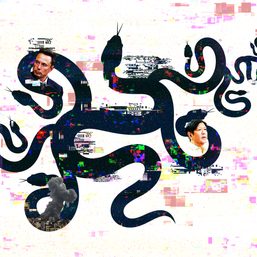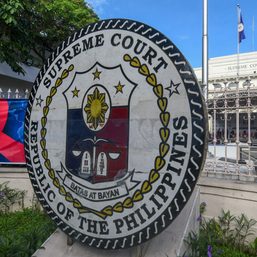SUMMARY
This is AI generated summarization, which may have errors. For context, always refer to the full article.
![[ANALYSIS] Disinformation comes for the courts](https://www.rappler.com/tachyon/2022/10/Law-Disinformation.jpg)
This country has had its share of court decisions that triggered public dissatisfaction. Yet, for one to openly threaten a judge with violence is a first. Consider this post: “So if I kill this judge…because there is no difference in my mind between a member of the CPP NPA NDF and their friends, then please be lenient with me.” Fortunately, after a “stern warning,” the Supreme Court issued a show cause order to the person responsible.
There are two ways to look at this. One is to view it as an isolated incident involving one “noisy/misguided” person. The other way is to step back and look at what’s happening across the world. The Center for Strategic and International Studies reported how disinformation campaigns worked to undermine the US justice system. They “increase overall mistrust and paranoia against democratic institutions.” In particular, the judiciary is “portrayed as corrupt, inept, and hypocritical.”
I spent two days at Google’s Asia-Pacific headquarters in Singapore exchanging insights with those on the frontlines of the fight against global disinformation. A key take-away: Democratic decline due to disinformation is accelerating. Another sobering thought is that according to a team that studies a country’s vulnerability to disinformation, one country had a vulnerability “score” markedly higher than others – the Philippines.
Typical of court decisions, the judge’s ruling rested on legal nuances (ie, effect of repealed laws; distinguishing “rebellion” from “terrorism”). But nuance dies in the vitriol of online posts. And when an influencer with a social media following in the millions dog whistles against the judiciary, the matter isn’t just about “one noisy person.” Speed, virality, and reach define the new paradigm that governments and judiciaries now grapple with.
The effects are now being felt. When the Supreme Court released its “stern warning” on threats which “endanger the lives of judges and their families,” it should have ended there. Instead, online actors started targeting the High Court itself. One posted that he was, “leaning towards believing that even that institution (the SC) may also be infiltrated by operatives from the terrorist group of the cpp-npa-ndf.” Incredulously, others echoed that the SC was censoring their right to free speech. A decade ago, these would have been unthinkable.
This is the new reality facing our courts. Where facts don’t matter and truth is no longer self-evident. And nuance, the lifeblood of law, is drowned in a tsunami of hate. If disinformation can convince millions of a flat-earth, or of mind-control vaccines, painting courts as “terrorist enablers” is all too easy.
Judiciaries are caught in this vortex. Social media can instantly spread rumor and false information on a scale none of us ever imagined. Judges on the other hand, are ethically and professionally prohibited from publicly defending themselves. Troll farm operators count on the misplaced confidence of those who still believe that the “truth will out.” Disinformation networks supercharge these effects. In eroding institutions, what used to take years, now only take months.
Fortify judicial systems
The timely action of the Supreme Court was a needed first step. The statements from stakeholders are also helpful. We need to do more. When disinformation targets a profession or institution, it doesn’t stop until public trust has been thoroughly shaken. Scientists, historians, media, and medical doctors have learned this the hard way.
Which is why some countries have begun fortifying their judicial systems against disinformation. The US Supreme Court initiated civic engagement programs targeting the grassroots. Judiciaries in the EU are moving in a similar proactive fashion. Based on shared data during the summit in Singapore, bottom-up, scaleable efforts present the best hope to preserve institutions from these assaults.
Punitive actions are necessary to address individual offenders. But against disinformation networks, we must “inoculate” entire communities. This means that the legal profession must reconnect with the public we serve. We can no longer presume that the legal nuances we take as “truths” are still appreciated by the public we impose them on. Does the public even remember why we shield judges and lawyers from threats of violence? It’s not because the law is a “divine” calling, or that judges are immune to criticism. We shield the profession because the very purpose of creating the law was to provide an alternative to violence.
No judge or justice can withstand a “firehose of disinformation.” To survive, we need to reflect on what makes our profession vulnerable. A legal/judicial system was supposed to be a better alternative to the arbitrariness of monarchs. The rise of “Tulfo justice” is a barometer of where the public’s trust is gravitating to. Troll farms are using this sentiment as fuel.
It is only right that we ask the public to defend the rule of law. But to do this with credibility, we must answer their question: why? – Rappler.com
John Molo practices commercial litigation and arbitration. He teaches Constitutional Law and is an officer of the IBP and sits on the Board of the Philippine Bar Association. He is a Past President of the Harvard Law School Alumni Association. He works with #FactsFirstPh in fighting global disinformation.
Add a comment
How does this make you feel?




![[EDITORIAL] Threads, ang bagong designer drug sa ating public space](https://www.rappler.com/tachyon/2023/07/animated-threads-disinformation-accountability-carousel.jpg?resize=257%2C257&crop_strategy=attention)




![[Newspoint] Fake press, undeserved freedom](https://www.rappler.com/tachyon/2024/04/newspoint-fake-press-undeserved-freedom-April-5-2024.jpg?resize=257%2C257&crop=318px%2C0px%2C720px%2C720px)




There are no comments yet. Add your comment to start the conversation.